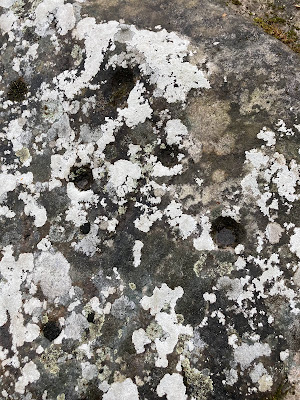We have continued our exploration of Holy Island, using the excellent guidebook by John Bevan (2018 2nd Edition). I cannot recommend the book highly enough, it has drawn our eyes to the small details of the islands spiritual, industrial and cultural past. Details which we may have easily over-looked simply using the OS map for information. It has given us the waypoints by which to punctuate our walks around Holy Island.
 |
| Hobthrush AKA St Cuthbert's Island |
One of the sites that we failed to explore, is the walk out at low tide to St Cuthbert's Island. Although I did spend probably an hour of each day, walking the main island's foreshore in front of it, looking for the enigmatic fossils known as St Cuthberts's Beads. The beads are the fossilised remains of Crinoids - from the Palaeozoic period, some 250 million years old.
At the end of these three days of fruitless searching, I am still content with the finding of some fossils in situ. still embedded in rock, near the Anglo-Saxon steading (see previous Blog entry).
 |
| Fossil-hunting |
 |
| the Castle Staithes, and mooring eye |
Bevan (ibid) tells us that the stiathes are the remains of the two wooden jetties which served the ships bringing coal to the Lime Kilns at the base of Lindisfarne Castle - and upon return transporting the quicklime to the mainland. Several iron mooring eyes also remain in situ, embedded in the rocky foreshore.
 |
| the Castle Staithes and mooring eyes |
 |
enjoying the crab sandwich
from the Post Office Cafe |
 |
rems. Osborne's Fort
(built in the 1670's) |
 |
| it would've been rude not to? |
The joy of Holy Island, is there is still so much more to explore - so a third visit is already on the cards. We plan to hire a cottage for the week, and maybe go a little bit later in the season to get a better understanding of the dune system in flower? Watch this space.
Food and Drink



































































